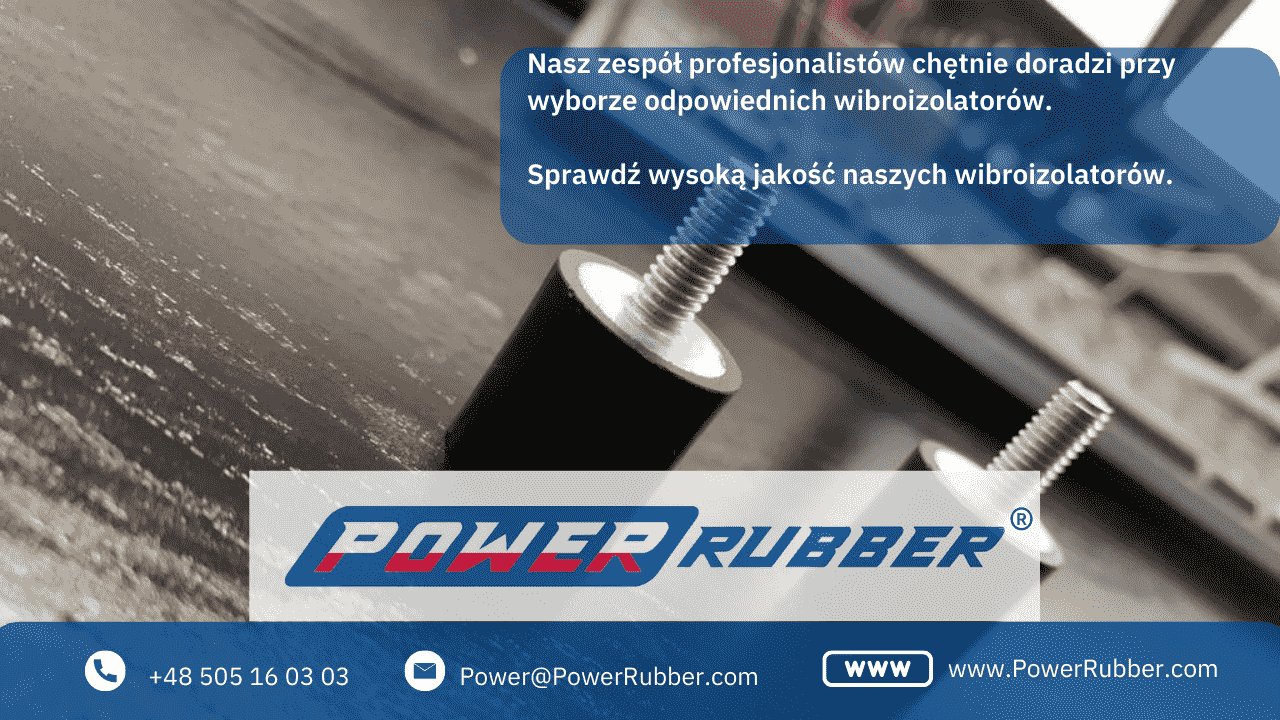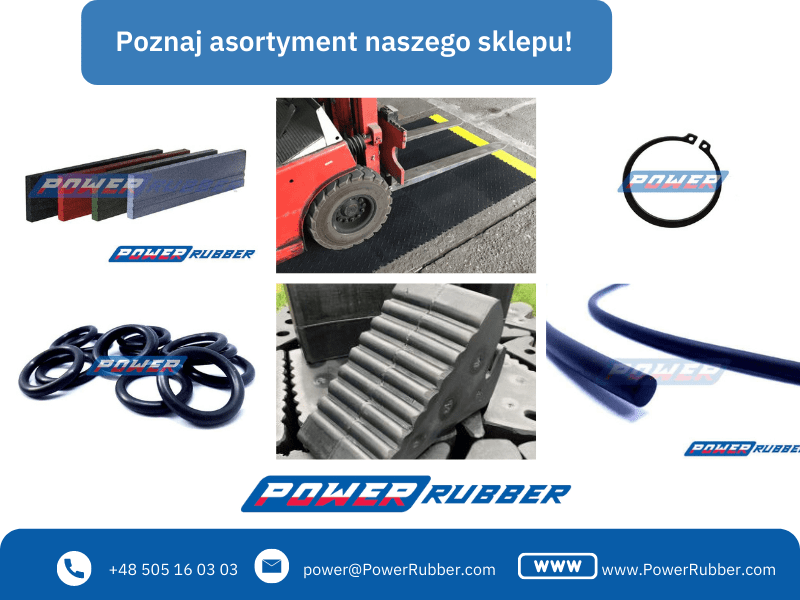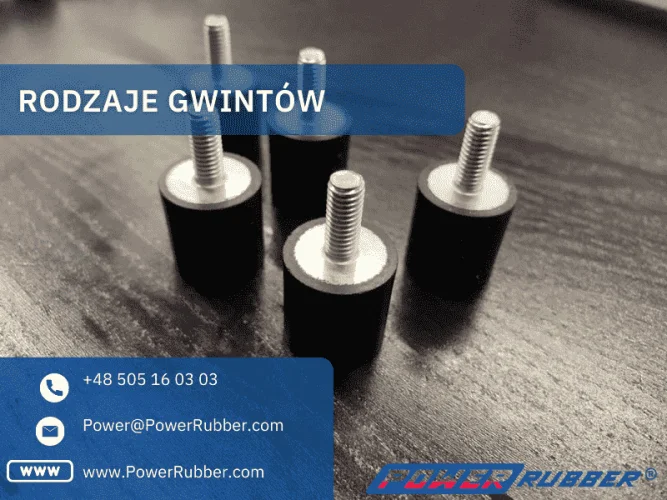Types of threads
18.01.2020
The types of threads can be divided according to the shape of the outline, the type of dimension, the direction of rotation, the unit of measurement and the ratio of the pitch to the diameter.. The connector is the basic element of a threaded connection. It consists of a bolt and a nut. The combination of bolt and nut gives us a resting threaded connection. There are direct and indirect threaded connections. The different types of threads are mainly used in mechanical engineering and its components, such as, for example, rubber shock absorbers. 

Basic thread types:
Thread types - outline shape:
- symmetrical trapezoidal (carries heavy loads in one and both directions, used e.g. in parallel vices or in bolts of elevators)
- trapezoidal asymmetrical (they work with one load direction, used e.g. in screw presses)
- triangular
- round (high fatigue strength, used e.g. in wagon joints)
- rectangular (used in unit production)
Thread types - type of dimension:
- internal (located inside the hole)
- external (located on the shaft)
Thread types - direction of rotation:
- left
- right (most often used)
Thread types - unit of measure:
- inch (the angle of the outline is 55 or 60 degrees)
- metric (the outline angle is 60 degrees)
Thread types - pitch to diameter ratio:
- ordinary (most often present in mass-produced elements)
- fine-threading (characterized by high self-locking, securing the threaded connection against loosening)
- coarse thread (used, for example, in resting connections that are often unscrewed)

Threads - Inch, Metric, and Size Chart
The threads result from cutting grooves along the centerline. The thread profile is created by passing the cut grooves through the thread axis. Due to the triangular shape of the outline, we distinguish inch and metric threads. Inch threads are divided into pipe and fine threads. They are used, among others by plumbers and gas workers. Metric threads are very durable due to their 60 degree profile angle. Their disadvantage is inaccurate alignment. A table of inch and metric thread sizes is provided below (Table 1).Metric threads
Metric threads have a triangular profile, mainly used for rest connections. They are most often marked with the letter "M" and belong to the fastening threads. We distinguish between regular and fine-threaded metric threads. Both coarse and fine metric threads can be right-handed or left-handed. Metric fine threads are used, among others in electrical installations, replacing the special Pg threads in many cases. Their outline angle is 60 degrees. Perfect for everyday use. Metric threads are very durable and therefore often used are also in industry. Self-locking (high force acting on the screw does not cause its rotation and unscrewing) and low sensitivity to inaccuracy of execution are other advantages that characterize metric threads.Metric threads - classes:
- fine (precision threads)
- medium fine (general purpose)
- coarse (used in materials that are difficult to machine)
Inch threads
Inch threads, also known as Whitworth threads, similarly to metric threads, have a triangular profile. They are used for pipe connections. Their outline angle is 55 degrees. We distinguish inch pipe threads and fine threads. Inch threads also include American (UNC), American fine (UNF) and American extra fine (UNEF) threads. They are ideal for air installations, plumbing, gas, some models of cars produced in the USA. The UNC thread is a plain thread, developed by William Sellers in 1864. Wszystkie informacje dotyczące gwintu UNC określane są normami ASME B1.1 oraz ISO 5864. Inch threads describe the diameter as inches, where 1 inch equals 2.54 cm.Inch tubular
Inch pipe threads can be used in pipe connections (plumbing or gas works). When using these types of threads, remember that the diameter is in inches. The UNC (Unified National Coarse) thread is the equivalent of the European metric thread with a nominal pitch. The UNC thread angle is 60 degrees. Is being used it for the production of fasteners, e.g. nuts and bolts.Inch fine thread
Inch fine threads have a thread angle range of 55 degrees. UNF (Unified National Fine) threads are the European equivalent of a metric fine pitch thread. The UNF thread angle is 60 degrees. Like UNC threads, UNF threads are also used in the production of fasteners (screws, bolts). Inch fine threads are commonly used in the United States. This type of thread was also developed by William Sellers. For example, UNF threads can be designated as follows: 3/8 "UNF or 3/8" -24UNF, where 24 is the number of turns per 1 inch.Trapezoidal threads
Trapezoidal threads are characterized by high durability. Among the trapezoidal threads, there are metric ISO trapezoidal threads and asymmetrical trapezoidal threads. The advantage of ISO metric trapezoidal threads is the possibility of using split nuts. The use of split nuts is helpful in adjusting and getting rid of axial play. Unlike metric ISO threads, unsymmetrical trapezoidal threads can only be loaded in one direction. Additionally, they are characterized by the highest durability. Asymmetrical trapezoidal threads are used, for example, in screw presses. They are resistant to carrying heavy loads with a high coefficient of friction. High-quality steel, from which the trapezoidal experimental threads are made, makes them extremely durable, thanks to which they are used in servicing electrical devices (e.g. screwdrivers), and in the construction of mechanical machines. Trapezoidal threads can also be used as lead screws in straps, closing motion in injection molding machines or as moving screws in screw presses.Thread designations
Thread designations according to PN and ISO standards are given in table 2
Directional threads
We divide the directional threads into left and right. Their division is related to the helix. A helix may define a cylindrical or a conical helix. It can be right- or left-handed. Left-hand directional threads are obtained by moving the screw counterclockwise upwards, right-hand directional threads (clockwise) by the movement of the screw right up. Right hand threads are most commonly used.Left-hand threads
Left-hand (left-hand) threads are screwed to the top left, i.e. counterclockwise. They are used much less frequently than right-hand directional threads. Left-hand threads can be successfully used in English (so-called tiled stoves) to prevent the door from opening while burning, in the radiator plugs, in gas valves (as protection against accidental unscrewing the gas) or automotive. They are used wherever there is a real risk of the screw loosening itself. Left-hand threads can also be combined with right-hand directional threads in the turnbuckle.Right-hand threads
Right-hand (right-hand) threads are turned in clockwise. This type of directional thread is commonly used. Right-hand threads are used wherever there is no risk of self-loosening or accidental unscrewing of the screw. It is worth adding that thanks to the combination of two types of directional threads - right and left, a turnbuckle is created, which is used, among others. when tightening the ropes.Thread holes
The holes for the threads should be carefully made. When choosing a drill bit, remember that its diameter should always be smaller than the thread diameter. Only a carefully selected drill bit will guarantee that the pair of threads will do the job in the right and efficient way. A specially prepared table is helpful when choosing the best drill diameter. Table 3 "Holes for threads - Drill selection table" explains how to properly select drill bits for threads. Which drill size will be used depends on the type of thread (metric nominal, metric fine or pipe thread). It is worth following the tips in the table to avoid any trouble with the selection of the appropriate drill bit for the thread.What thread holes do I need?
If you ask yourself the question: "What thread holes are needed?", The answer can be found in Table 3 below. You will learn how to carefully and precisely select the appropriate diameter of the drill for the thread size marked M1, M3, and G1 / 16. It is conditioned by different types of threads, i.e .: nominal metric thread, metric fine thread, tubular-cylindrical thread.Summary - Thread table
The thread table below shows how to obtain a hole for metric threads, metric fine threads, and parallel thread.Types of threads and their application. Check out the most popular sizes
What threads are in the bulbs?
Want to replace a bulb, but don't know which one will match your lighting? Check what threads are in the bulbs! We divide the threads in the bulbs into: Edison (pressed), halogen and car bulbs.What threads are in Edison bulbs?
- E27 (characterized by a "large thread", most often used in the household, adapted to a 230 V power supply)
- E14 (characterized by a "small thread", most often used in lamps and wall lamps, adapted to work in installations with a voltage of 230 V)
- E40 (it is used in street lamps)
What threads are there in halogen bulbs?
- GU10 (10mm shaft leg spacing, mounted on a latch, used in ceiling luminaires, adapted to a 230 V power supply)
- MR16 (pressed in, used in suspended ceilings, furniture showcases, adapted to work in two voltage variants: 12 V and 230 V)
- MR11 (reflector plug, most often used in decorative room lighting)
- G9 (9 mm shaft leg spacing, mainly used for decorative lighting)
- G6.35 (characterized by thickened legs, the most commonly used in lamps)
- G4 (pressed in, adapted to work in the voltage variant of 12 V, mainly used in furniture fittings in the bathroom or kitchen)
What threads are in car bulbs?
- parking (screw thread)
- C10W thread (used to illuminate license plates, 42 / 43mm long)
- C5W thread (used to illuminate license plates)
- W5W thread (position lights and car interior lighting)
What threads are there in vibration isolators?
Rubber vibration isolatorsare metal-rubber elements equipped with internal and external threads. Standard types of threads used in rubber buffers are:- M4
- M6
- M8
- M10
- M12
- M14
- M16
- M18
- M20
The length of the thread is adjusted to the needs and requirements of the machines and devices that eliminate vibrations.
We invite you to download the PDF version

